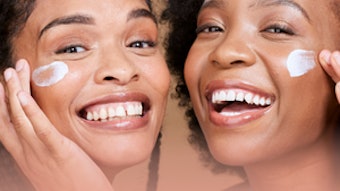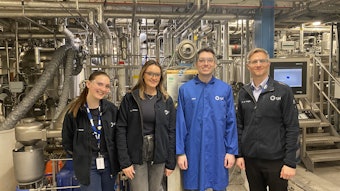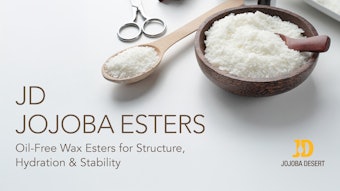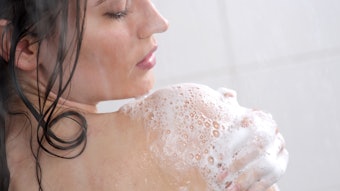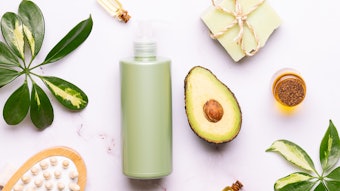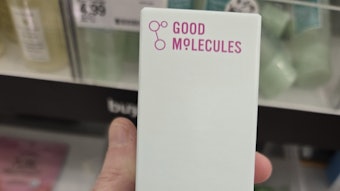When using a hair conditioning product such as a shampoo, consumers expect their hair to be cleansed, repaired and nourished. But they also expect their hair to be soft and shiny, with volume and a light feel. In a word, consumers expect hair to look natural.
Log in to view the full article
When using a hair conditioning product such as a shampoo, consumers expect their hair to be cleansed, repaired and nourished. But they also expect their hair to be soft and shiny, with volume and a light feel. In a word, consumers expect hair to look natural.
Shampoo formulations have evolved throughout the past decades, from simple cleansing and foaming bases with poor hair conditioning performance, to fairly sophisticated systems containing a variety of surfactants combined with one or more conditioning polymers and a silicone agent.
While the inclusion of silicones in shampoo has been common since the 1990s, many limitations have prevented a more widespread use of these effective systems. Current challenges are the ability to deposit conditioning actives effectively on different types of hair, such as damaged/oxidized and virgin zones, while enabling desired adjustments to the overall sensorial experience of hair management during and after shampoo. Among the conditioning and delivery polymers introduced recently in the cosmetic industry is polyquaternium-74 (PQ-74), whose physicochemical properties and hair surface modification abilities are described in this article.
PQ-74 Performance Mechanism
Conditioning polymers are usually of cationic nature and the most commonly used are derived from the chemical modification of polysaccharides such as guar and cellulose. It is well-known in the industry that this class of water-soluble polymers can deposit on the hair surface thanks to a mechanism called flocculation or coacervation that occurs while the shampoo is applied on a wet head.1 Flocculation depends on the surfactant base, the pH and the ionic strength of the formulation. It has been reported that the nature of the polymer backbone has a significant effect on the polymer ability to flocculate. In that respect, cationic guars have always been the reference, outperforming synthetic and cellulose-based conditioning polymers.2
PQ-74 is a novel synthetic polymer for hair conditioning. It was developed by Rhodia to be a highly flocculating polymer, one that deposits on hair as effectively as high molecular weight cationic guar. PQ-74 is an amphoteric copolymer of acrylic acid anionic monomer and a proprietary cationic monomer of Rhodia. Its net charge density is a function of formulation pH.
Flocculation: The flocculation behavior of four conditioning polymers was evaluated by transmittance measurement with a UV spectrophotometer at 600 nm in a cell 10 mm by 10 mm, for different dilution ratios of shampoo compositions. The polymers tested were PQ-74 and the following conventional conditioning polymers: polyquaternium-10 (PQ-10), polyquaternium-7 (PQ-7) and guar hydroxypropyltrimonium chloride (cationic guar). This same group of polymers was used for all the tests reported in the present article. Shampoos were formulated with 14% sodium laureth sulfate (SLES-2EO), 2% cocamidopropyl betaine (CAPB) and 0.2% of conditioning polymers.
Figure 1 depicts the flocculation of PQ-74, which is similar to cationic guar. Images of PQ-74 shampoos at the dilution ratios 1, 2 and 3 in Figure 2 illustrate how turbid the solutions are, which is linked to the quantity of polymer flocs.
On the other hand, it appears that PQ-7 does not flocculate in these conditions, and that PQ-10 has a different profile. The minimum of transmittance is obtained for a higher ratio of dilution and its value remains fairly high, which is a sign that there are only a few hydrophobic flocs of PQ-10.
Deposition of PQ-74 on both virgin and damaged hair: Damaged hair is a generic term that encompasses various kinds of damages. When hair is dyed, oxidation is more frequent but oxidation differs from damage due to UV or sun light, and also from damage caused by combing and brushing.
Oxidized hair is also called hydrophilic damaged hair. It is a hydrophilic surface of amphoteric nature with a high charge density. By contrast, virgin hair is hydrophobic, essentially of anionic nature with a low charge density.
Hydrophobic flocs deposit on the surface but during the rinsing step these flocs are more easily washed out from the hydrophilic, amphoteric surface, than from the hydrophobic one. Moreover, the oxidized hair surface is very heterogeneous. It could be seen as a chess board, where black squares are hydrophobic areas and white squares hydrophilic ones. Indeed, these differences in the physical-chemistry of virgin and oxidized hair surfaces explain the poor deposition of conditioning ingredients on damaged zones.
There is direct correlation between the ability of conditioning polymers to form hydrophobic flocs during the shampoo process and their effective deposition on the hair surface. A simple method to evaluate the deposition of polymers bearing cationic charges is the Rubin dye test, also called the red dye test.
Upon shampooing, a conditioning polymer deposits on hair surface. The hair tress is then treated with a solution containing an anionic red dye. The dye reacts with cationic sites at the surface to produce a red-colored substrate whose color intensity is related to the amount of deposited cationic polymer. The red dye is then extracted at 60°C using a sodium chloride solution and titrated using UV spectrophotometric analysis.
For reasons already mentioned, depositing hydrophobic flocs on hydrophobic virgin hair is much simpler than the challenging task of depositing hydrophobic flocs on hydrophilic damaged or oxidized hair. In one red dye test conducted in-house, the ratio of PQ-74 deposition on virgin hair to damaged hair was close to 2:1. A ratio that low suggests that PQ-74 can be formulated for both virgin hair and damaged hair.
Deposition of silicone: Efficient conditioning polymers are those that flocculate during hair shampooing, i.e., before dilution in rinsing. Polymer that does not flocculate is not effective, as seen in Figure 1. Moreover, it also is possible to use polymers or to formulate polymers in a way that flocs are preformed in the shampoo, prior to any dilution. This generally is done with a certain category of polymer chemistries that are not the most efficient with respect to deposition of silicone on hair.
The hydrophobic flocs that are formed vary in size with surfactant compositions and are generally a few tens of microns in size. These objects have come to be regarded as potential vehicles to deliver particulates dispersed in the shampoo base onto the hair surface, especially silicone oil droplets and antidandruff agents such as zinc pyrithione.
An in-house test was conducted to determine the effect of droplet size on silicone deposition by PQ-74. Classic high viscosity dimethicone oil was emulsified with laureth-7 or laureth-8. Shampoos tested contained 1% of silicone and 0.2% of PQ-74 in a SLES/CAPB base. Dimethicone deposited on hair surface was extracted from the keratinous surface with tetrahydrofuran (THF) solvent and the silicone oil in THF was dosed using gel permeation chromatography (GPC). The results obtained with this method were quantitative. This same technique was used to show that adding some common tertiary surfactants does not diminish dimethicone deposition by PQ-74 and may improve it. See Table 1.
The most efficient combinations were created by associations of PQ-74 with submicron dimethicone emulsions. For an emulsion with droplets 3 µm in size, 245 ppm of dimethicone per gram of hair were deposited, which corresponds to a deposition yield of approximately 25%. For submicron emulsions, this yield increases to above 55%, and is constant over droplet sizes of 0.4 µm (500 ppm), 0.6 µm (550 ppm) and 1.0 µm (550 ppm). Therefore, a very interesting conditioning system is the association of a PQ-74 with a dimethicone emulsion of 0.6 µm. For the rest of this article, the term PQ-74DIM will be used to refer to this proprietary systema of PQ-74 and a submicron dimethicone emulsion emulsified with laureth-7.
Once again using the GPC procedure previously described, PQ-74DIM was benchmarked against cationic guar, PQ-10 and PQ-7 in association with the same submicron dimethicone emulsion. The measured values of dimethicone deposition onto virgin hair in ppm per gram of hair were 600, 600, 72 and 24, respectively. A simple correlation clearly appears when comparing these silicone deposition results with the polymer flocculation profiles in Figure 1. PQ-10 and PQ-7 poorly deposit dimethicone on virgin hair, while they weakly flocculate upon dilution. Similarly, PQ-74DIM deposits a high level of dimethicone, as does cationic guar.
The major challenge of hair conditioning in rinse-off products is to maintain sufficient deposition of conditioning agents on hair after rinse cycles, and in that regard the selection of cationic polymer and silicone emulsion conditioning agents is crucial to the performance of the shampoo. PQ-74DIM has been shown to be an effective way to meet that challenge.
Hair Conditioning, Repairing
Detangling: Because PQ-74DIM deposits effectively on the hair surface, it was anticipated that this system would provide hair conditioning benefits such as wet hair combing and detangling. These benefits were evaluated using tensile testing equipmentb that monitors the force developed to comb a hair tress from top to bottom.
Tresses of damaged/oxidized hairc were treated with shampoo containing 1.0% of the submicron dimethicone emulsion and 0.2% of PQ-74, cationic guar or PQ-10. For each treatment, six tresses were treated and combed 10 times. The percentage reduction of combing force versus untreated wet hair for PQ-74DIM, cationic guar, PQ-10 and the shampoo base was 25%, 25%, 6% and 1.5%.
This data indicates that PQ-74DIM had approximately the same level of reduction in wet combing force, i.e., ~25%, as the cationic guar with dimethicone. On the other hand, PQ-10 with the dimethicone emulsion had a fairly low performance to improve the combing of oxidized hair tresses. This finding is not surprising and fully in agreement with the previous data on the ability of PQ-10 to deposit silicone on hair surface.
Overall hair conditioning of
Caucasian hair: The overall hair conditioning properties that are brought by this system were evaluated in half-head salon tests carried out at the Schrader Institute in Germany on damaged hair, and compared to a PQ-74DIM-based shampoo. The shampoo composition was exactly the same as those tested in wet combing with the tensile equipment. The panel was composed of 10 women with damaged hair, i.e., oxidized, colored and dry hair. Most of the women had long hair. The hair dresser carried out two hair shampooings. The first was a pre-wash. The second came as the hair dresser judged the hair on various sensorial benefits while washing, combing and styling each panelist. As presented in Figure 3, four different hair conditioning attributes were assessed: wet hair detangling, wet hair feel, dry hair detangling and dry hair feel.
Figure 3 illustrates that PQ-74DIM outperformed PQ-10 with dimethicone for each of the four conditioning attributes evaluated. Damaged/oxidized hair is much more porous than virgin hair and can absorb large quantities of water while wet. In these conditions, damaged hair is far more fragile than in the dry stage. Thus, the ability to smoothly detangle this type of hair is critical to ensure the integrity of the fiber. The detangling performance of PQ-74DIM is linked to the ability of PQ-74 to flocculate and thus deposit on hair surface and deliver actives such as dimethicone submicron emulsion. That performance also is linked to the quality of the dimethicone emulsion. In the shampoo, silicone oil is dispersed in droplets, the quantity of which is a cubic function of the diameter of the droplets. For instance, an emulsion with droplets 0.6 µm in size, such as the one associated in PQ-74DIM, will have 100 times as many droplets as an emulsion with droplets 3 µm in size; i.e., one droplet 3 μm in diameter can be divided into 100 droplets 0.6 µm in diameter. Thus, the oil is deposited in a much more homogeneous way, which is key to quickly coating the hair fiber.
The advantages of PQ-74DIM over PQ-10 and dimethicone alone on wet and dry damaged hair were demonstrated by this in-use evaluation. This test was conducted in Germany on Caucasian hair. How would PQ-74DIM perform on Asian hair?
Overall hair conditioning of Asian hair: In Western countries, damaged hair is more and more common. Meanwhile, Asia is witnessing the increasing popularity of hair grooming. Essentially influenced by Japan and Korea and a trend more and more followed by young people, the coloring, dyeing and bleaching of hair has gained popularity in Asian countries since the end of the 1990s. Consequently, there is an increasing demand in Asia for products that provide a high degree of conditioning and protection to the hair fiber.
A panel test in China evaluated the performance of PQ-74DIM on the damaged/oxidized hair of 15 Asian women. The shampoo formulations tested were free of thickening polymers and were stabilized with a fine-tuned association of surfactants. Shampoo was applied in the same way as in the Caucasian hair study, and the same four hair conditioning attributes were assessed.
The results of half-head evaluations are depicted in Figure 4 and show that PQ-74DIM outperforms the system of PQ-10 with dimethicone on those four hair conditioning benefits. Differences in performance evaluated by the hair dresser were statistically significant and were in full agreement with the previous data generated on Caucasian hair.
This result confirms the versatility of this association, which is effective on virgin and damaged hair, for Asian and Caucasian hair types. Moreover, it demonstrates that the system is effective in different surfactant bases. In the Caucasian test, shampoos were formulated with a stabilizing polymer, whereas in the Asian test a cocamide MEA was incorporated to ensure formulation stability.
Enhancing Hair Shine and Natural Look
The most effective conditioning polymers such as high molecular weight cationic guar provide a strong after-feel to the wet hair. That after-feel can be perceived by consumers as an effective treatment and conditioning of the hair. However, in some cases, consumers associate this strong feel to over-conditioned hair fibers and thus tend to over-rinse their hair. Hence, some consumers are looking for a conditioning system that provides a squeaky clean feel in the wet stage and also ensures the excellent hair detangling.
Buildup: The buildup of PQ-74, cationic guar and PQ-10 was evaluated from repeated shampoo applications on virgin hair. Hair tresses were treated 1, 3 and 10 times and polymer deposition was measured with the red dye test described previously. The amount of dye adsorbed by the hair surface is linked to the cationic charges on the polymer backbone and does not allow for a direct comparison of polymers. Thus, dye intensity measured by UV-spectrophotometry was normalized to 100% after the first shampoo application. The shampoo formulation was a simple surfactant base of 14% of SLES-2EO and 2% of CAPB at pH of 5.
Results displayed in Figure 5 show that neither PQ-74 nor cationic guar builds up after multiple shampoo applications, but PQ-10 does build up. Therefore, PQ-74 is a sustainable choice for the formulator because it will not induce over-conditioning of the hair fiber and will be beneficial to the hair volume and styling. This absence of buildup was also confirmed in sensorial assessments by hair dressers at the Schrader Institute.
The buildup of silicone on hair can be of concern for formulators developing 2-in-1 conditioning shampoos. Thus, repeated shampoo applications on virgin hair tresses were carried out with a formulation comprising 1.0% of the laureth-7-emulsified dimethicone emulsion of 0.6 µm and 0.2% of one of these conditioning polymers: PQ-74, cationic guar or PQ-10. Two hair tresses were used per conditioning system and the deposition of the dimethicone was measured after extraction with THF by GPC. As shown in Figure 6, the system of cationic guar and dimethicone emulsion, widely used in 2-in-1 shampoos, produced a silicone deposition profile similar to that of PQ-74DIM after 1, 3, 5 and 10 repeated shampooings. Evaluation of the system based on PQ-10 provides little information because this polymer barely deposits the silicone oil.
Overall, it appears from the evaluations presented in Figure 5 and Figure 6 that PQ-74DIM does not build up on hair upon multiple applications (evaluated for up to 10 shampooings). The association of these conditioning actives is thus of great interest for the formulator because it provides benefits for hair detangling and repairing, light silky touch and squeaky clean feel during rinsing, and can be repeatedly used by the consumer without jeopardizing these performances.
Rinsability: The removal of dimethicone buildup by rinsing with a clarifying shampoo was tested on two hair tresses washed 10 times with a 2-in-1 conditioning shampoo containing PQ-74DIM at 2.5%, which corresponds to 0.2% PQ-74 and 1% of the dimethicone emulsion. In the case presented here, the clarifying shampoo was a simple formulation of SLES-2EO. It appears (Figure 7) that after one application, 50% of the dimethicone was removed and 80% was removed after the third clarifying shampoo. Thus, dimethicone is only temporarily bound to hair surface and PQ-74 does not prevent its removal by a clarifying shampoo.
Shine: Hair oxidation from coloring, perming or waving treatments dramatically denatures the hair fiber. It changes from a hydrophobic, smooth surface to a hydrophilic, rough one. Repetition of these treatments results, especially at the tips, in severe hair damage. Consumers perceive this damage as unhealthy hair, without volume or shine, and with an overall hair style that does not look natural compared to the prior virgin state of hair.
Many attributes convey the signal of a healthy hair that looks natural. Volume and color are some of them, but more importantly, the luster or shine of the hair is the most significant property that recalls healthiness and the natural state of hair.
A 2-in-1 conditioning shampoo containing one of three polymers was evaluated for its effect on the shine of blond hair tresses. Three tresses were evaluated for each polymer. Shine was measured with a gloss meter after 10 consecutive shampooings. The shampoo was a surfactant base of SLES-2EO at 14% and cocamidopropyl betaine at 2% with one of three conditioning polymers: PQ-74DIM; a system of PQ-10 and PEG-12 dimethicone; or a system of PQ-10 and the submicron dimethicone emulsion emulsified with laureth-7. Results are shown in Table 2.
PQ-74DIM enabled a significant improvement in hair shine when formulated in the 2-in-1 conditioning shampoo. This result is first linked to the level of dimethicone deposited on hair surface, which explains why the PQ-10-based systems are under-performing. A second factor is PQ-74’s unique chemical structure. High-depositing polymers of high molecular weight will not adsorb flat on a surface, and thus will tend to reduce the shiny appearance of hair. PQ-74 behaves differently. Because of its acrylic acid monomers, its cationic sites and the high flexibility of its backbone, it will adsorb flat and thus will not reduce the hair shine. Thus, PQ-74 is able to form a thin and homogeneous coating on the hair surface. That coating neither disrupts the light scattering nor reduces the intensity of the light reflected back.
Conclusion
The association of PQ-74 with a dimethicone emulsion in a single liquid product form is a means to efficiently restore the natural look of hair and maximize positive signals to consumers such as hair shine, smooth feel, hair volume and manageability.
In addition to these benefits, this novel system based on PQ-74 and dimethicone emulsion simplifies processes for the manufacturing of shampoos, does not require sophisticated mixing tools and gives the formulator access to a range of performances with only one conditioning ingredient. The formulator thus can meet demanding formulation projects aimed at improving hair wellness and consumer well-being.
Acknowledgments: The author wishes to acknowledge Anne-France Leron, Julie Sainte-Catherine, Caroline Mabille, Stéphanie Chiron, Wang Chan, Brian Chung and Aline Seigneurin for their contribution to the work discussed in this article.
References
1. ED Goddard and RB Hannan, Cationic polymer / anionic surfactant interactions, J Colloid Interface Sci 55 73–78 (1976)
2. US Pat 5,085,857, Conditioning shampoo comprising a surfactant, a non-volatile silicone oil and guar hydroxypropyltrimonium chloride as a cationic conditioning polymer, ES Reid and AM Murray (Feb 4, 1992)
3. S Rogasik, N Martin, JM Ricca, W Wielinga and O Anthony, The challenge of damaged hair shampoos: Which links between benefits on damaged hair and measurable physical chemical parameters?, SOFW Journal 125(11) 32–39 (1999)



